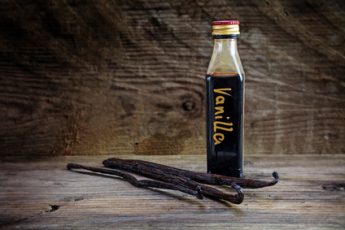Vanilla is used across the world to flavor and enhance recipes of all types. But in general, we only use vanilla extract, the liquid extraction of vanilla pods.
But more and more, other types of vanilla products are entering use, including thicker pastes, and of course the raw bean itself. But what are the differences in vanilla paste vs vanilla extract, and which should you choose?
What is vanilla bean extract?
Quick Navigation
Pure vanilla bean extract is what you probably think of when you’re thinking of vanilla. It’s found in bottles and generally made from vanilla beans that have been soaked in a mixture of alcohol and water to suffuse the fluid with the flavor of vanilla.
In terms of usage, one teaspoon full of vanilla extract is generally equal to one-third of a vanilla pod. Or, to put it the other way around, a vanilla pod is generally as strong as three teaspoons of extract. You can even use it to make fudge taste better.
What is vanilla bean paste?
Vanilla bean paste is a thick, syrupy paste that contains real vanilla bean seeds. It’s literally what you get when you scoop the inside of a vanilla pod out and whip it into a paste with a little water.
In terms of usage, most jars will have specific instructions on them, but you’re normally good to substitute one large teaspoon of vanilla bean paste per vanilla pod needed.
What’s a good substitute for vanilla extract?
Anyone who has ever baked anything has probably used vanilla extract in some form. It’s versatile and popular.
But sometimes vanilla extract isn’t the right choice, because of undue cost, or because it contains alcohol. If that’s the case, you can easily substitute vanilla extract with your choice of the below.
- Maple syrup: Vanilla can be exchanged for maple syrup, or pancake syrup, on a one to one basis. Furthermore, the change in flavor will be minimal, making this a great choice.
- Almond extract: You can substitute vanilla extract for almond extract on a two for one basis, meaning use half as much almond extract as you would vanilla.
- Other extracts: (lemon juice, orange, etc) Feel free to use other extracts in the same way as almond milk or oil, but consider complimentary flavors and the end result.
- Vanilla milk: If you’ve got vanilla flavored soy or almond milk at hand, then you can use it instead of vanilla extract on a one to one basis.
- Brandy and rum: If alcohol isn’t the problem, then either of these will be fine. As usual, an equal measure is fine.
- Vanilla paste, powder or beans: Use vanilla powder or paste as you would vanilla extract, or if you’re using raw beans, the seeds from half a seed pod per tablespoon of expected vanilla paste.f
When you’re choosing which substitute to use, consider the recipe you’re making, and the end result you’re aiming for.
How to make your own vanilla extract at home
If you’re the type that prefers the real thing and you’ve got a little bit of time, you can try making your own vanilla extract in the comfort of your own home.
All you need is:
- A cup of vodka
- 3 vanilla pods
- A jar with a tight lid
- A knife
Split the beans lengthwise with the knife, and place them inside the jar. Cover them in the vodka, making sure they’re completely submerged, and place the pot in a cool, dark place.
Once per week, go back to it, checking that the pods are still completely submerged, and giving it a little shake to mix things up a bit.
Leave to mature for at least eight weeks, et voila, your own vanilla extract.
The Verdict
No matter which vanilla product – vanilla paste vs vanilla extract – you end up using, as long as you’re smart about your usage you’ll be able to enjoy the beautiful, delicate flavor of vanilla in everything that you want.
If you’ve got any interesting uses for vanilla, or you think we’ve missed a good vanilla substitute, make sure you let us know. Happy cooking!

